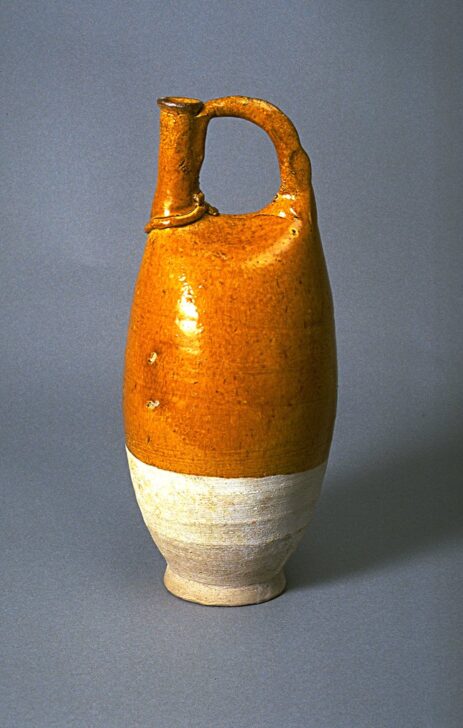Flask
Chinese

Description
From the mid-tenth to the early twelfth centuries, the Khitan Liao, a sinicized tribe of Mongol origin, ruled over much of north China. So powerful was the Liao that the contemporary Chinese dynasty of Northern Song (960-1126) regularly sent tribute north to keep the peace.
Liao pottery borrows heavily from Tang and Northern Song models, but Liao ceramic production also shows an originality and vitality that reflects the cosmopolitan nature of Khitan culture, particularly in the area of vessel shape. Liao potters adopted shapes from objects made in other materials and from objects of West Asian and Middle Eastern origin. For example, the flask shaped vessel imitates the shape of leather bags used by the horse-riding Khitan to keep kumis, an alcoholic drink made from mare’s milk. The bag-shaped ovoid ewer topped with a spout to one side and a loop handle was also used as a wine flask. Its shape is loosely based on a Middle Eastern form made in metal, and ultimately the oenochoe wine jugs of ancient Greece.
(Label for UMMA Chinese Gallery Opening Rotation, March 2009)
Subject Matter:
From the mid-tenth to the early twelfth centuries, the Khitan Liao, a sinicized tribe of Mongol origin, ruled over much of north China. So powerful was the Liao that the contemporary Chinese dynasty of Northern Song (960-1126) regularly sent tribute north to keep the peace.
Liao pottery borrows heavily from Tang and Northern Song models, but Liao ceramic production also shows an originality and vitality that reflects the cosmopolitan nature of Khitan culture, particularly in the area of vessel shape. Liao potters adopted shapes from objects made in other materials and from objects of West Asian and Middle Eastern origin.
Physical Description:
This is a stoneware flask with amber glaze on the upper portion. The lower portion is unglazed, showing white slip.
Usage Rights:
If you are interested in using an image for a publication, please visit https://umma.umich.edu/request-image/ for more information and to fill out the online Image Rights and Reproductions Request Form.